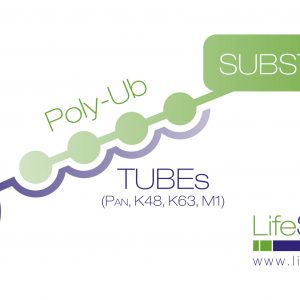Specifications
Von Hippel-Lindau, or VHL, is an E3 Ligase that mediates ubiquitination and degradation of target proteins. VHL is seen to play a large role in tumor suppression, particularly due to its interactions with HIF. VHL can be used as the required E3 ligase in PROTAC (Proteolysis Targeting Chimera) drug design, protein degradation studies and selectivity profiling.
The VHL complex is a multi-subunit ubiquitin ligase constituted with VHL, Elongin B, Elongin C, Cullin-2 and Rbx1. Elongin B (ELOB) and Elongin C (ELOC) are heterodimers that bind to the BC-box motif present in SOCS- &VHL-box protein families. VHL is the substrate recognition component that brings target specificity.
In this specific E3 ligase complex, the ELOB/ELOC works as an adapter between target proteins and Cullin-2/Rbx1 in VHL-box E3 ubiquitin ligases. This complex is ideal for studying PROTAC interactions with biophysical and HTRF assays to monitor the ternary complex. This complex has Flag tagged proteins that are suitable for pulldown assays.
VHL Complex, E3 Ligase Info
| Species | Human |
| Source | HEK293 |
| Tag | See Datasheet |
| Molecular Weight | VHL: 25 kDa, ELOB: 14 kDa, ELOC: 13 kDa |
| Quantity | 10 µg or 50 µg |
| Concentration | Variable |
| Formulation | 40 mM Tris-HCL, pH 8.0, 110 mM NaCl, 2.2 mM KCl, 20% glycerol, 3 mM DTT |
| Storage | -80°C, avoid freeze/thaw cycles |
Begin learning more about PROTAC and E3 ligases today by reaching out via our ‘Contact Us’ page.
Interested in analyzing E3 ligases like Von Hippel-Lindau? Click here to find out more.





Reviews
There are no reviews yet.